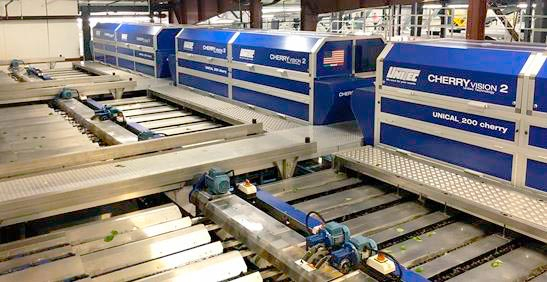Generally, the fruit from the totes will travel through an alternate cluster cutter. This cluster cutter belt will be running at a slower speed to the conventional line as it has been shown to reduce damage.
Packing
Cluster cutter (continued from last issue)
As cherries are required to be single fruits for grading, a cherry stem separation system must be in place. Although most Tasmanian growers require pickers to separate cherries into singles in the field, and several other packhouses utilise a hydraulic stem separation system, metal blade saw type cluster cutters are most commonly found.
These machines consist of a large belt to feed cherries, plastic tines to catch and lift joined stems, and a series of high-speed saw blades to cut those joined stems.
In Australian systems, these saw type cluster cutters have been shown to be the single biggest contributor of fruit pitting.
Researchers found that up to 20% of all fruit was being damaged by cluster cutter operations.
Since it has long been hypothesised that fruit impacting on the plastic tines of the cluster cutter causes pitting, slowing belt speeds to reduce this impact force unsurprisingly results in less pitting.
It is unclear how much pitting is reduced by limiting impact force, and how much is reduced by increased fruit density on the belts causing a lower percentage of fruit to directly impact the tines.
Regardless, studies such as these show time and again that any machinery on a packing line that physically impacts the cherries must be designed to handle the fruit with the gentlest care possible.
Electronic graders
All packhouses of commercial size utilise electronic graders to individually size cherries and sort defects into various grades.
Historically, fruit was mechanically sized with stepped rollers and defects individually sorted by humans. Continuously evolving high-definition camera and software technology of graders has made hand sorting virtually obsolete.
With all cherries sold by size, the precision achievable with optical sizing allows producers to present a more visually appealing final box, as well as improving final packouts by removing the need for oversizing.
Defect detection has also improved, with modern machines claiming to remove almost all defects as well as sorting by firmness and detecting internal bruising.
Packing lines still using humans to manually sort do not have this ability to sort fruit by firmness and efforts to do so will generally result in even more bruising to the fruit. Considering also that fruit with internal bruising has a higher respiration rate and as such will begin to decay earlier, having the ability to cull this fruit will extend the shelf life of the final product.
Once fruit has passed through the electronic grader, individual cherries are dropped off at designated drop points depending on size, colour, and presence of defects.
From these drops, cherries are transferred to sorting tables and finally box filling stations. Cherries can be transferred by rubber or plastic belts but water flumes are generally preferred for several reasons. Water flumes are much narrower than solid belts and can be fitted to take corners, giving packhouses much greater flexibility to transfer fruit, often in confined areas.
This water is also usually chilled to 0–4C, as fruit moving through the packing room will begin to warm. Maintaining a chilled water flume will result in a lower fruit pulp temperature at box filling as opposed to dry belts.
The greatest single advantage to water flumes is the reduction of bruising and pitting when compared to fixed belts.
Every time a cherry falls on to a hard surface, the chance of causing physical damage increases, especially when fruit pulp temperature is cooler (Figure 2).
(cont next issue)
See this article in Tree Fruit Nov 2021






















